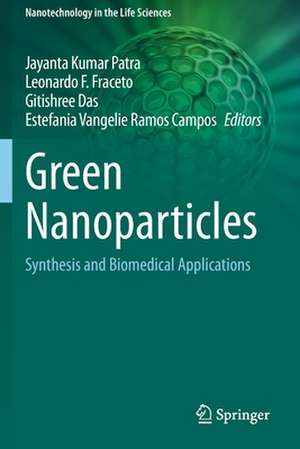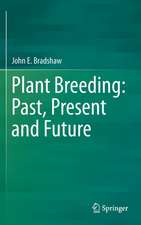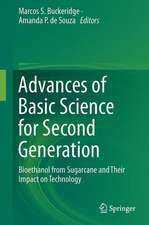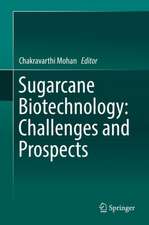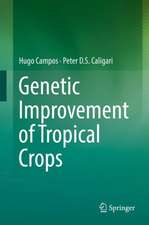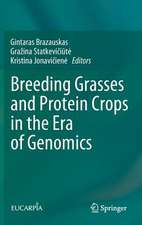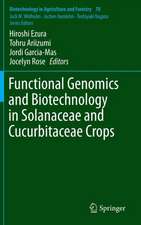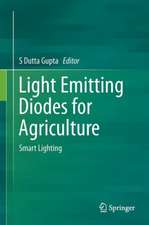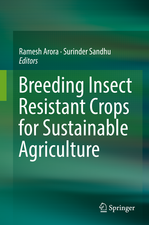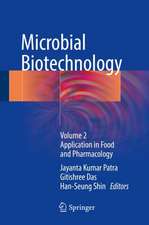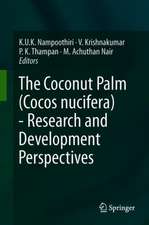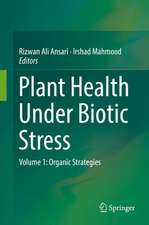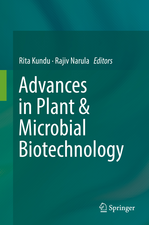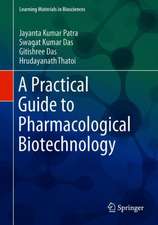Green Nanoparticles: Synthesis and Biomedical Applications: Nanotechnology in the Life Sciences
Editat de Jayanta Kumar Patra, Leonardo F. Fraceto, Gitishree Das, Estefânia Vangelie Ramos Camposen Limba Engleză Paperback – 7 apr 2021
But the biogenic syntheses of monodispersed nanoparticles with specific sizes and shapes have been a challenge in biomaterial science. Nanoparticles are of great interest due to their extremely small size and large surface-to-volume ratio, which lead to both chemical and physical differences in their properties (e.g., mechanical properties, biological and sterical properties, catalytic activity, thermal and electrical conductivity, optical absorption and melting point) compared to bulk of the same chemical composition. Recently, however, synthesizing metal nanoparticles using green technology via microorganisms, plants, viruses, and so on, has been extensively studied and has become recognized as a green and efficient way for further exploiting biological systems as convenient nanofactories. Thus the biological synthesis of nanoparticles is increasingly regarded as a rapid, ecofriendly, and easily scaled-up technology.
Today researchers are developing new techniques and materials using nanotechnology that may be suitable for plants to boost their native functions. Recently, biological nanoparticles were found to be more pharmacologically active than physico-chemically synthesized nanoparticles. Various applications of biosynthesized nanoparticles have been discovered, especially in the field of biomedical research, such as applications to specific delivery of drugs, use for tumor detection, angiogenesis, genetic disease and genetic disorder diagnosis, photoimaging, and photothermal therapy. Further, iron oxide nanoparticles have been applied to cancer therapy,hyperthermia, drug delivery, tissue repair, cell labeling, targeting and immunoassays, detoxification of biological fluids, magnetic resonance imaging, and magnetically responsive drug delivery therapy.
Nanoparticle synthesis for plant byproducts for biomedical applications has vast potential. This book offers researchers in plant science and biomedicine the latest research and opportunity to develop new tools for the synthesis of environmentally friendly and cost-effective nanoparticles for applications in biomedicine as well as other various fields.
| Toate formatele și edițiile | Preț | Express |
|---|---|---|
| Paperback (1) | 1657.65 lei 6-8 săpt. | |
| Springer International Publishing – 7 apr 2021 | 1657.65 lei 6-8 săpt. | |
| Hardback (1) | 1663.80 lei 6-8 săpt. | |
| Springer International Publishing – 7 apr 2020 | 1663.80 lei 6-8 săpt. |
Din seria Nanotechnology in the Life Sciences
- 20%
 Preț: 938.71 lei
Preț: 938.71 lei - 18%
 Preț: 1119.71 lei
Preț: 1119.71 lei - 18%
 Preț: 946.21 lei
Preț: 946.21 lei - 18%
 Preț: 1029.58 lei
Preț: 1029.58 lei - 18%
 Preț: 1012.70 lei
Preț: 1012.70 lei - 18%
 Preț: 1123.19 lei
Preț: 1123.19 lei - 5%
 Preț: 1169.22 lei
Preț: 1169.22 lei - 18%
 Preț: 954.62 lei
Preț: 954.62 lei - 18%
 Preț: 1121.94 lei
Preț: 1121.94 lei - 18%
 Preț: 1132.98 lei
Preț: 1132.98 lei - 18%
 Preț: 952.89 lei
Preț: 952.89 lei - 18%
 Preț: 944.99 lei
Preț: 944.99 lei - 15%
 Preț: 642.83 lei
Preț: 642.83 lei - 18%
 Preț: 1117.99 lei
Preț: 1117.99 lei - 18%
 Preț: 1105.37 lei
Preț: 1105.37 lei - 18%
 Preț: 954.45 lei
Preț: 954.45 lei - 18%
 Preț: 1117.82 lei
Preț: 1117.82 lei - 18%
 Preț: 959.04 lei
Preț: 959.04 lei - 18%
 Preț: 1111.85 lei
Preț: 1111.85 lei - 24%
 Preț: 901.53 lei
Preț: 901.53 lei - 18%
 Preț: 1007.49 lei
Preț: 1007.49 lei - 20%
 Preț: 587.02 lei
Preț: 587.02 lei - 18%
 Preț: 950.52 lei
Preț: 950.52 lei - 18%
 Preț: 1013.65 lei
Preț: 1013.65 lei - 5%
 Preț: 706.77 lei
Preț: 706.77 lei - 18%
 Preț: 1112.15 lei
Preț: 1112.15 lei - 15%
 Preț: 653.33 lei
Preț: 653.33 lei - 18%
 Preț: 1125.55 lei
Preț: 1125.55 lei - 18%
 Preț: 1119.87 lei
Preț: 1119.87 lei
Preț: 1657.65 lei
Preț vechi: 2021.52 lei
-18% Nou
Puncte Express: 2486
Preț estimativ în valută:
317.18€ • 332.06$ • 262.45£
317.18€ • 332.06$ • 262.45£
Carte tipărită la comandă
Livrare economică 05-19 aprilie
Preluare comenzi: 021 569.72.76
Specificații
ISBN-13: 9783030392482
ISBN-10: 3030392481
Pagini: 394
Ilustrații: X, 394 p. 72 illus., 64 illus. in color.
Dimensiuni: 155 x 235 mm
Greutate: 0.57 kg
Ediția:1st ed. 2020
Editura: Springer International Publishing
Colecția Springer
Seria Nanotechnology in the Life Sciences
Locul publicării:Cham, Switzerland
ISBN-10: 3030392481
Pagini: 394
Ilustrații: X, 394 p. 72 illus., 64 illus. in color.
Dimensiuni: 155 x 235 mm
Greutate: 0.57 kg
Ediția:1st ed. 2020
Editura: Springer International Publishing
Colecția Springer
Seria Nanotechnology in the Life Sciences
Locul publicării:Cham, Switzerland
Cuprins
Preface.- Biomedical applications of stimuli responsive hydrogels.- Nanosystem for local anesthetics: A review of patents and commercial products.- Application of biosynthesized metal-based nanoparticles.- Topical delivery of drugs for skin diseases treatment.- Challenges in nanobiosensors for bioscience applications.- Anti-cancer nanomaterials.- Evaluation of the safety of nanomaterials in medical applications.- Green Synthesis of nanoparticles by mangrove plant and its biomedical application.- Biological synthesis of nanoparticles and their applications.- Nanoparticles in biomedical applications.- Nanoparticles and its application in DNA technology.- Nanotoxicology in Plants.- Nanoparticles on Phytosynthesis of plants: effects and role.- Carbon nanotubes as plant growth regulators: future prospects.- Index.
Notă biografică
Jayanta Kumar
Assistant Professor
Research Institute of Biotechnology and Medical Converged Science
Dongguk University
Republic of Korea
Leonardo Fernandes Fraceto
Professor
São Paulo State University (UNESP)Institute of Science and Technology of Sorocaba
Brazil
Gitishree Das
Assistant Professor
Research Institute of Biotechnology and Medical Converged Science
Dongguk UniversityRepublic of Korea
Estefânia Vangelie Ramos Campos
São Paulo State University (UNESP)
Institute of Science and Technology of Sorocaba
Brazil
Textul de pe ultima copertă
Nanotechnology is the application of science to control matter at the molecular level. It has become one of the most promising applied technologies in all areas of science. Nanoparticles have multi-functional properties and have created very interesting applications in various fields such as medicine, nutrition, bioenergy, agriculture and the environment.
But the biogenic syntheses of monodispersed nanoparticles with specific sizes and shapes have been a challenge in biomaterial science. Nanoparticles are of great interest due to their extremely small size and large surface-to-volume ratio, which lead to both chemical and physical differences in their properties (e.g., mechanical properties, biological and sterical properties, catalytic activity, thermal and electrical conductivity, optical absorption and melting point) compared to bulk of the same chemical composition. Recently, however, synthesizing metal nanoparticles using green technology via microorganisms, plants, viruses, and so on, has been extensively studied and has become recognized as a green and efficient way for further exploiting biological systems as convenient nanofactories. Thus the biological synthesis of nanoparticles is increasingly regarded as a rapid, ecofriendly, and easily scaled-up technology.
Today researchers are developing new techniques and materials using nanotechnology that may be suitable for plants to boost their native functions. Recently, biological nanoparticles were found to be more pharmacologically active than physico-chemically synthesized nanoparticles. Various applications of biosynthesized nanoparticles have been discovered, especially in the field of biomedical research, such as applications to specific delivery of drugs, use for tumor detection, angiogenesis, genetic disease and genetic disorder diagnosis, photoimaging, and photothermal therapy. Further, iron oxide nanoparticles have been applied to cancer therapy,hyperthermia, drug delivery, tissue repair, cell labeling, targeting and immunoassays, detoxification of biological fluids, magnetic resonance imaging, and magnetically responsive drug delivery therapy.
Nanoparticle synthesis for plant byproducts for biomedical applications has vast potential. This book offers researchers in plant science and biomedicine the latest research and opportunity to develop new tools for the synthesis of environmentally friendly and cost-effective nanoparticles for applications in biomedicine as well as other various fields.
Caracteristici
The latest research, new techniques and new materials of nanotechnology for plants to boost their functions Detailed discussion of synthesis of nanoparticles Coverage of biomedical applications such as specific drug delivery, use for tumor detection, angiogenesis, genetic disease and genetic disorder diagnosis, photoimaging, and photothermal therapy Fully referenced for further reading
